BibTex format
@article{Palchetti:2020:10.1175/bams-d-19-0322.1,
author = {Palchetti, L and Brindley, H and Bantges, R and Buehler, SA and Camy-Peyret, C and Carli, B and Cortesi, U and Del, Bianco S and Di, Natale G and Dinelli, BM and Feldman, D and Huang, XL and C-Labonnote, L and Libois, Q and Maestri, T and Mlynczak, MG and Murray, JE and Oetjen, H and Ridolfi, M and Riese, M and Russell, J and Saunders, R and Serio, C},
doi = {10.1175/bams-d-19-0322.1},
journal = {Bulletin of the American Meteorological Society},
pages = {E2030--E2046},
title = {FORUM: unique far-infrared satellite observations to better understand how Earth radiates energy to space},
url = {http://dx.doi.org/10.1175/bams-d-19-0322.1},
volume = {101},
year = {2020}
}

